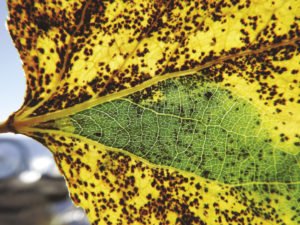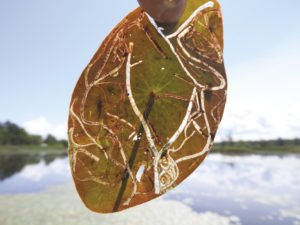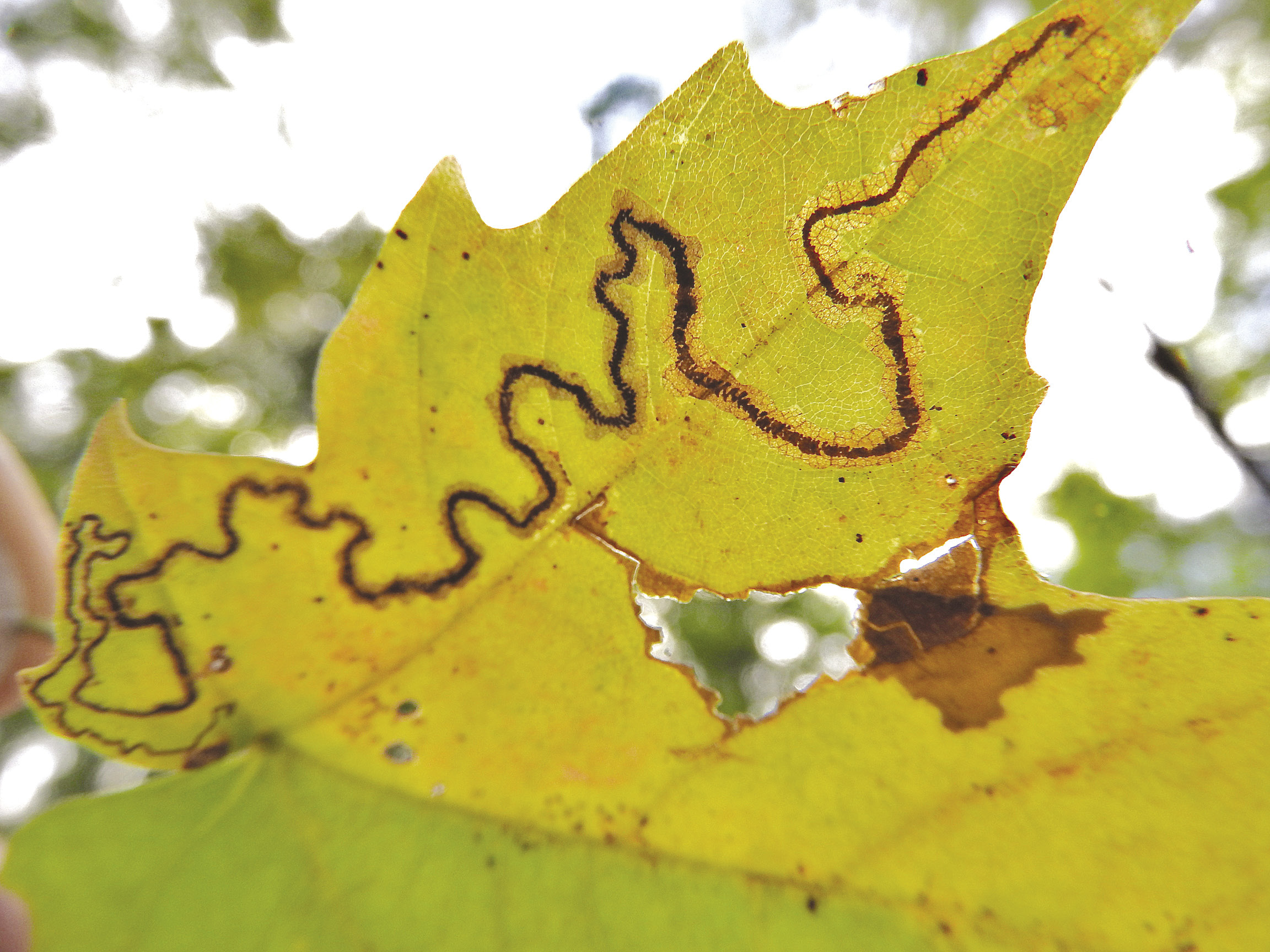North Shore—October is a fantastic month to look at leaves. Red maples may be past their peak, but other species hold their fall colors longer, and variations in micro-climates allow beauty to ripple across the landscape in eccentric patterns. If you’re lucky, you can find a rainbow of hues on just one hillside.
While the long view is scenic and gorgeous, the short view can be fun, too. Leaves that once were high in the windswept canopy now crinkle under your feet in drifts. Often the patterns found there—in the fallen leaves—are just as fascinating.
Squiggly lines are probably my favorite pattern to admire in a leaf and I’ve been happy to find some good ones. These wildly meandering, partially transparent squiggles are typical of the trails left by leaf miners, a group of insects (including moths, sawflies, flies and beetles) whose larvae feed on the insides of a leaf between its “skins.”
On a sugar maple leaf I found recently, the trail seemed to tell a story. The drama began near the base of the leaf, where the path of the leaf miner started out slim, about the width of a felt-tipped pen. The line itself was composed of a dark center stripe and paler, translucent edges. It recorded the growth—essentially the childhood—of a moth larva of the species Glaucolepis saccharella. The larva excavated the mine by eating a juicy substance called “mesophyll” out from between the upper and lower epidermis of the leaf.

As I traced the widening trail with my finger, I imagined the larva growing bigger as it fed. Eating means pooping, and this caterpillar both deposited pellets of frass and wiggled its tail back and forth at a near-constant rate. The result was a dark, zig-zag line down the mine that looks just like a fancy stitch on a sewing machine.
Near the end of the mine, a wide, clear section represented the caterpillar’s final day before its metamorphosis, when it joined the “clean plate club.” After that, the larva popped out of the leaf, dropped to the ground, and formed a cocoon to overwinter before completing its metamorphosis to a moth next spring. Even with the larva long-gone, examining the widening trail in the leaf felt like watching my Facebook friend’s kid grow up before my eyes.
The squiggles of leaf miners aren’t the only fun pattern to look for in the sweet-smelling drifts of autumn leaves. I love walking through an aspen stand when about half the leaves are down. Sunbeams glitter through the golden canopy. Sunlight sparkles from raindrops perched on the waxy confetti scattered thickly across the path. All is not yellow, though. Sometimes I see just one leaf bearing a bright green trapezoid like a little flag near the base of one side of its midrib. Occasionally, almost every leaf in the pile sports that same patch of green.
These little blemishes on the golden leaves are actually a testament to how tightly life packs itself together in the world. Even the stem of a leaf can be a home.
Each splash of green was caused by a single moth larva. Back in July, a small, brown moth laid an egg on the leaf petiole (stem). By September, a translucent larva hatched and bored into the petiole, causing the stem to swell a bit into a small gall. Munching its way up inside the leaf under the cover of darkness, the larva interrupted the mechanisms the tree normally uses to draw chlorophyll out of the leaf during the waning days of autumn.

The result was a little green island in the yellow aspen leaf. All of that happened while the leaf was still high in the canopy. By floating with its home down to the ground, the larva is able to steal a few more bites of food from its emerald pantry, and then take advantage of the cool, damp, microclimate on the forest floor to safely pupate.
Fall beauty doesn’t stop at the forest edge. Have you paddled through a patch of water shield lately? Their palm-sized, oval leaves often form great mats in the same habitat as water lilies. In autumn, their brilliant bursts of red and yellow paint the lakes with a spectacular mosaic of color. And just like the other leaves, water shield also hosts its own insect artist.
Like the leaf miners in the maple, a midge larva carves curving trails on the water shield leaf—but with two big differences. First, the trails are not interior mines. The larva actually cuts the upper epidermis of the leaf away, scrapes off the good stuff, and sews the leaf shards back together with silk to make a roof over the channel. This setup attracts moisture, and you’ll always notice a film of water along the raised length of the squiggle. The larva needs that air to breathe.
What else does the larva need? We’re not sure. For the first half of its life, the tiny midge larva is MIA. Between egg and leaf, scientists have yet to discover how the larvae survive. Only when half-grown do the larvae find themselves a water shield leaf and start channeling. This results in another difference from the maple mine—the trails in water shield are the same width from start to finish, since the larva does less growing during their construction.
Most of us are content to admire autumn leaves as they turn hillsides to rainbows, but you never know what drama and what mysteries you might find if you take a closer look.






